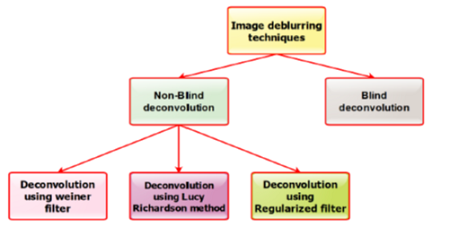


Indian Journal of Science and Technology
Year: 2021, Volume: 14, Issue: 24, Pages: 2051-2068
Original Article
S Pooja1, S Mallikarjunaswamy2*, N Sharmila3
1Research Scholar, Department of ECE, Research Scholar, Department of ECE, Bangalore,
560060, Karnataka, India
2Associate Professor, Department of ECE, JSS Academy of Technical Education, Bangalore,
560060, Karnataka, India
3Assistant Professor, Department of EEE, RNS Institute of Technology, Bangalore, 560060,
Karnataka, India
*Corresponding Author
Email: [email protected]
Received Date:17 April 2021, Accepted Date:06 June 2021, Published Date:16 July 2021
Objectives: To develop image deblurring algorithm to effectively recover the original image from the captured blurry and noisy image. Methods: A novel image deblurring algorithm using adaptive priors is proposed. The adaptive priors vary the sparsity induced based on factors such as the type of blur affecting the image, image region, statistical parameters regarding the blur kernel and/or statistical predictions on the blur kernel. The proposed algorithm using adaptive priors improves the quality of the deblurred result, when compared with various recent image deblurring algorithms. Finding: the work contains a case study with regard to certain standard parameters. It is observed that proposed method is better in terms of frequency response, Peak signal-tonoise ratio (PSNR) and Structural Similarity Index (SSIM) values in comparison with other priors. Novelty: the proposed priors lead to the most effective results for image deblurring using the Bayesian framework. The proposed method improves the performance by 30% in PSNR and 45% in SSIM values in dB with uniform kernel size 12 * 12 and improves performance by 30 % in PSNR and 32% SSIM with a standard deviation of 3.5. The proposed method enhances the frequency response of the real-time image restoration process. Applications: Some important applications include the restoration of medical images such as MRI images, CT images where the intensity of these radiations is maintained to avoid damage to human organs. Remote sensing images captured through drones at a specified time cannot be retaken and hence restoring such images is very important. Similarly restoring images from CCTV footage, astronomical images.
Keywords: Blind Image Deblurring; Maximum a Posteriori Estimation; Image priors; Regularization; Structural Similarity Index (SSIM) and Peak signal-to-noise ratio (PSNR)
© 2021 Pooja et al. This is an open-access article distributed under the terms of the Creative Commons Attribution License, which permits unrestricted use, distribution, and reproduction in any medium, provided the original author and source are credited. Published By Indian Society for Education and Environment (iSee)
Subscribe now for latest articles and news.